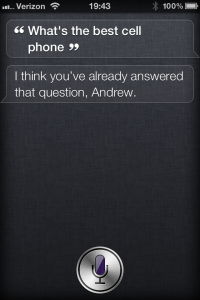It’s probably no secret to anyone who knows me that I am a big fan of Apple. While I recognise there are some legitimate criticisms that could be leveled against them (for instance their approach to security could probably be a little more accepting of the fact that malware exists), I think that, on the whole, they are a great company, making wonderful products that people want to use.
What it’s tempting to forget, in the world where the iPhone and iPad now exist, is just how incredibly innovative Apple is, on a regular basis. The latest iteration of the iPhone garnered a lot of attention (naturally), and some of it was negative – based on the fact that Apple hadn’t called it iPhone 5 (ok, not quite that, but if Apple had called it v5, then maybe the criticisms would have been quieter). However, the people who criticize Apple for the similar form factor etc, have really missed the point. Even the camera being 8megapixels and full 1080p video capable isn’t the ‘main meal’.
What’s really revolutionary, is Siri – the personal assistant. I’ve been playing with Siri since yesterday, when I got the new iPhone 4S, and I have not yet ceased to be amazed by its power and ‘intelligence’. Ask it what the stock price for Apple is, or what the weather in Hong Kong will be and Siri will be ready with an answer. Say “How about some Italian food?” and she will come up with a list of restaurants in the area that serve that cuisine. You can dictate email, instruct her to send SMS (Send Gerald an SMS saying “Thank you” – and it works), or ask for a reminder or alarm, Siri will know what to do and how to respond. But the most fun thing? She has a sense of humour, as witnessed by the screenshot below.

I love technology, but I don’t mean I like complexity – just the opposite. I love technology that makes life easier because it is well designed and it ‘just works’. That’s why I love what Apple does, because this seems to be their main rule. Siri is yet another quiet revolution from the Cupertino company. I’m sure we’ll see more, though Steve Jobs was an inspiring figure, he was only one individual, and Apple is a very big company. There are plenty of people there who will want to see his legacy maintained.
